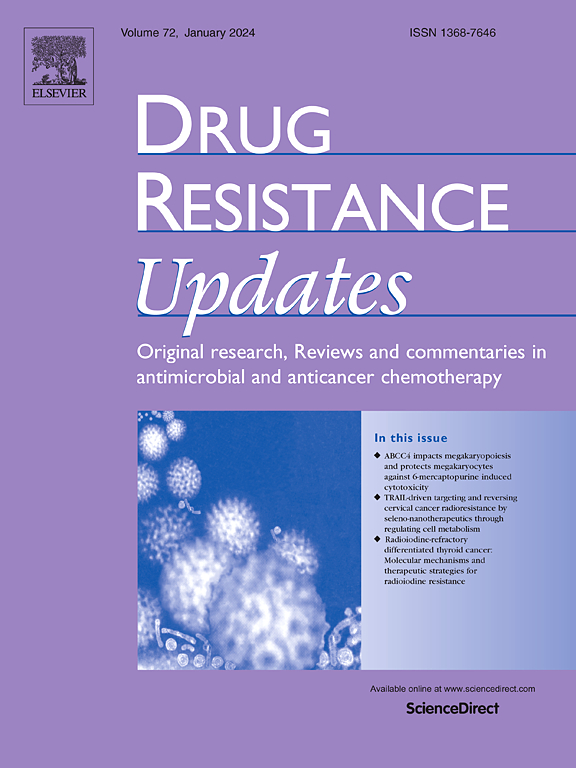EMT和癌症干细胞:治疗耐药的驱动因素和有希望的治疗靶点
IF 21.7
1区 医学
Q1 PHARMACOLOGY & PHARMACY
引用次数: 0
摘要
癌症仍然是造成死亡的主要原因,在全球造成大量死亡和疾病。它仍然是一个重大的全球健康问题,极大地影响着世界各地的发病率和死亡率。治疗耐药性是癌症治疗面临的主要挑战,是标准治疗和靶向治疗有效性的重要障碍。这种耐药性通过各种机制发展,使肿瘤细胞适应并逃避化疗、放疗和靶向治疗的破坏性影响。最终,这将导致疾病的复发和进展。本文综述了上皮-间质转化(epithelial-mesenchymal transition, EMT)和肿瘤干细胞(cancer stem cells, CSCs)在促进化疗耐药和转移中的双重作用。EMT是一个动态和可逆的生物学过程,上皮细胞获得间质特性,增加其侵袭性和对程序性细胞死亡的抵抗力。CSCs是癌细胞的一个子集,具有自我更新的能力,在肿瘤复发和治疗抵抗中起着至关重要的作用。EMT和CSCs紧密相连,共同增强癌细胞的可塑性、转移能力和治疗耐药性。在癌细胞中启动EMT可以产生csc样群体,促进肿瘤复发和扩散。这种相互作用强调了靶向EMT和CSC途径的重要性,以开发更有效的治疗策略,解决治疗耐药性和预防转移。有希望的方法包括使用天然物质、小分子和纳米技术来阻断关键的信号通路并干扰耐药性机制。更深入地了解EMT和CSC可塑性背后的分子因素对于制定针对肿瘤异质性和改善临床结果的个性化治疗至关重要。本文章由计算机程序翻译,如有差异,请以英文原文为准。
EMT and cancer stem cells: Drivers of therapy resistance and promising therapeutic targets
Cancer continues to be a primary cause of death, resulting in substantial mortality and illness globally. It remains a significant global health issue, greatly affecting morbidity and mortality across the world. Therapeutic resistance poses a major challenge to cancer treatments, acting as a significant barrier to the effectiveness of both standard and targeted therapies. This resistance develops through various mechanisms that allow tumor cells to adapt to and escape the damaging effects of chemotherapy, radiation, and targeted therapies. Ultimately, this leads to disease recurrence and progression. This review examines the dual roles of epithelial-mesenchymal transition (EMT) and cancer stem cells (CSCs) in promoting chemoresistance and metastasis. EMT is a dynamic and reversible biological process in which epithelial cells acquire mesenchymal characteristics, increasing their invasiveness and resistance to programmed cell death. CSCs are a subset of cancer cells with the ability to self-renew and play a crucial role in tumor relapse and resistance to treatment. EMT and CSCs are closely interconnected, collaboratively enhancing cancer cell plasticity, metastatic ability, and treatment resistance. The initiation of EMT in cancer cells can generate a CSC-like population, which promotes tumor recurrence and spread. This interaction highlights the importance of targeting both EMT and CSC pathways to develop more effective treatment strategies that address treatment resistance and prevent metastasis. Promising approaches include using natural substances, small molecules, and nanotechnology to block critical signaling pathways and interfere with resistance mechanisms. A more thorough understanding of the molecular factors underlying EMT and CSC plasticity is crucial for crafting personalized treatments that target tumor heterogeneity and improve clinical outcomes.
求助全文
通过发布文献求助,成功后即可免费获取论文全文。
去求助
来源期刊

Drug Resistance Updates
医学-药学
CiteScore
26.20
自引率
11.90%
发文量
32
审稿时长
29 days
期刊介绍:
Drug Resistance Updates serves as a platform for publishing original research, commentary, and expert reviews on significant advancements in drug resistance related to infectious diseases and cancer. It encompasses diverse disciplines such as molecular biology, biochemistry, cell biology, pharmacology, microbiology, preclinical therapeutics, oncology, and clinical medicine. The journal addresses both basic research and clinical aspects of drug resistance, providing insights into novel drugs and strategies to overcome resistance. Original research articles are welcomed, and review articles are authored by leaders in the field by invitation.
Articles are written by leaders in the field, in response to an invitation from the Editors, and are peer-reviewed prior to publication. Articles are clear, readable, and up-to-date, suitable for a multidisciplinary readership and include schematic diagrams and other illustrations conveying the major points of the article. The goal is to highlight recent areas of growth and put them in perspective.
*Expert reviews in clinical and basic drug resistance research in oncology and infectious disease
*Describes emerging technologies and therapies, particularly those that overcome drug resistance
*Emphasises common themes in microbial and cancer research
 求助内容:
求助内容: 应助结果提醒方式:
应助结果提醒方式:


